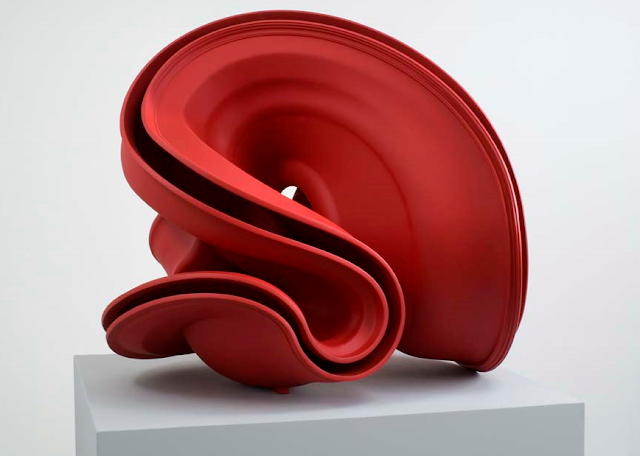.
Kim Guiline, Untitled, 1967. Oil on canvas, 38.19 x 51.18 inches 97 x 130 cm. Courtesy the artist, Lehmann Maupin, New York and Hong Kong, and Gallery Hyundai, Seoul. Photo: Max Yawney.
Lehmann Maupin announces the gallery’s inaugural exhibition for Kim Guiline, the first solo presentation of his work in the United States. The lauded Korean artist is one of the foundational members of the Dansaekhwa movement that emerged in South Korea during the 1970s. The exhibition will feature a survey of work that includes rarely shown paintings from the 1960s, his well-known black and white paintings from the 1970s, and bright monochrome paintings from the 1980s-2000s.
Dansaekhwa translates to “monochromatic painting,” and is also identified by experimental modes of paint application—scraping or pushing of pigments through canvas—that aimed to break away from classical approaches to art making. The resulting paintings were considered to be avant-garde, both aesthetically and in their criticism of political and art establishments. Kim Guiline’s paintings thus can be seen as a reflection of the sociopolitical landscape of Korea during the 1970s, a period of authoritarian rule and government surveillance. In contrast to propagandistic art praising the government, Kim Guiline produced abstract paintings that connected Korean heritage to the natural environment, often expressing a spiritual relationship to color and materiality.
In this exhibition, viewers are invited to consider the nuances of Kim Guiline’s work that firmly place him among his Dansaekhwa contemporaries while also delineating his improvisations upon the methodologies of this group. His paintings from the 1960s were inspired by his childhood dreams and demonstrated an interest in geometry and color-field abstraction. In the 1970s, he was working with a more restrained palette in order to explore the numerous narrative and formal possibilities of black and white pigments. During the 1980s, his work developed to include small repetitive squares and egg-shaped dots that became signature gestures in his monochrome canvases. By the 1990s, Kim Guiline was working primarily with five colors: black, blue, red, yellow, and green, allowing him to prioritize surface, texture, and brushwork. Like many Dansaekhwa artists, Kim Guiline is interested in exploring the possible spiritual associations of color.
Contrary to his peers who frequently use white, Kim Guiline often paints with black. Though the color typically has ominous associations, for Kim Guiline, it is representative of creation, renewal, and beginning.
As a whole, Kim Guiline’s practice can be identified by his dedication to the medium of oil paint and the accentuation of color and flatness across all periods of his work. To achieve a matte surface, the artist perfected a technique of using newspaper to absorb the excess oils from the paint. Equally unique is his treatment of layering individual colors on the canvas, rather than pre-mixing his pigments. The accumulation of these layers, upwards of 30 in a single painting, is what achieves the intensity and depth of color that reverberates in his paintings, despite the restrictive palette. Repeated, overlapping marks atop this layered, matte surface draw attention to the artist’s handling of material and invite the viewer to consider the philosophical implications behind the thick accumulation of paint. Kim Guiline’s works present a series of metaphorical propositions about the act and subject of painting that invite us to consider the meaning of the abstract image created by layering oil paint.
Kim Guiline (b. 1936, Gowon, Korea; lives and works in Paris) graduated from Hankuk University of Foreign Studies, South Korea in 1960; Dijon University, France in 1965; École and Nationale des Beaux-Arts, Paris in 1968; and received his BFA from École Nationale Supérieure des Arts Décoratifs, Paris in 1971. His work has been featured in numerous international exhibitions and biennials including Color Pool, Gyeonggi Museum of Modern Art, Ansan, South Korea (2015); Inhabiting the World, Busan Biennale, Busan, South Korea (2014); Scenes vs Scenes, Buk Seoul Museum of Art, Seoul, South Korea (2013); Dansaekhwa: Korean Monochrome Painting, National Museum of Modern and Contemporary Art, Gwacheon, South Korea (2012); Qui is Full, Daegu Art Museum, Daegu, South Korea (2011); Korean Abstract Art 1958-2008, Seoul Museum of Art, Seoul, South Korea (2008); and The Opening Exhibition, Seoul National University Museum MoA, Seoul, South Korea (2006). His work is held in numerous public and private collections including Busan Museum of Art, Busan, South Korea; Daegu Art Museum, Daegu, South Korea; National Museum of Contemporary Art, Gwacheon, South Korea; and the Seoul Museum of Art, Seoul, South Korea.




















